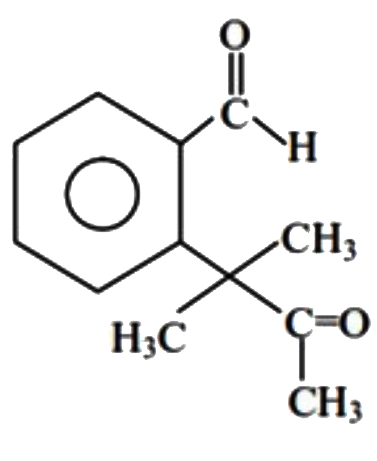Identify the compounds (A) and (B).
(A)(C11H12O)Gives(+ve)Iodoform testO3/Red−−−−→(B)(C10H10O2)Gives(+ve)iodoform test+CH2=O
(B) is symmetrical p-subsituted compound. (Ignore ozonolysis of benzene ring at the initial stage).
To identify the compounds (A) and (B), we will follow a systematic approach based on the information provided in the question and the video transcript.
Step 1: Analyze the Molecular Formula of Compound A
Given that compound A has the molecular formula C11H12O, we need to determine its structure.
Hint: Look for the presence of functional groups that can give a positive iodoform test.
Step 2: Determine the Double Bond Equivalent (DBE)
The double bond equivalent (DBE) can be calculated using the formula:
DBE=(2C+2+N−H−X)2
For C11H12O:
- C=11
- H=12
- O=1
- N=0
- X=0
Calculating DBE:
DBE=(2×11+2−12)2=(22+2−12)2=122=6
Hint: The DBE indicates the number of rings and multiple bonds in the structure.
Step 3: Identify the Structure of Compound A
Since the DBE is 6, and knowing that benzene contributes 4 to the DBE (3 double bonds + 1 ring), we have 2 remaining DBE. This suggests that compound A has a benzene ring and two additional double bonds.
Given that both compounds give a positive iodoform test, compound A must contain a methyl ketone group (−C(=O)CH3).
Hint: Consider structures that include a benzene ring and a methyl ketone.
Step 4: Propose a Structure for Compound A
A possible structure for compound A could be:
C6H5C(=O)CH2C(=O)CH3
This structure has a benzene ring, a methyl ketone, and satisfies the molecular formula C11H12O.
Step 5: Analyze the Reaction with Ozone
When compound A undergoes ozonolysis, it produces compound B, which has the formula C10H10O2 and also gives a positive iodoform test.
Hint: The ozonolysis reaction typically cleaves double bonds, leading to the formation of carbonyl compounds.
Step 6: Identify the Structure of Compound B
Since compound B is symmetrical and para-substituted, it can be represented as:
C6H4(C(=O)CH3)2
This structure indicates that compound B has two methyl ketone groups at the para position on the benzene ring.
Step 7: Confirm the Structures
- Compound A: C6H5C(=O)CH2C(=O)CH3
- Compound B: C6H4(C(=O)CH3)2
Both compounds give a positive iodoform test due to the presence of methyl ketone groups.
Final Answer
- Compound A: C6H5C(=O)CH2C(=O)CH3
- Compound B: C6H4(C(=O)CH3)2
Given that compound A has the molecular formula C11H12O, we need to determine its structure.
The double bond equivalent (DBE) can be calculated using the formula:
DBE=(2C+2+N−H−X)2
For C11H12O:
- C=11
- H=12
- O=1
- N=0
- X=0
DBE=(2×11+2−12)2=(22+2−12)2=122=6
Since the DBE is 6, and knowing that benzene contributes 4 to the DBE (3 double bonds + 1 ring), we have 2 remaining DBE. This suggests that compound A has a benzene ring and two additional double bonds.
A possible structure for compound A could be:
C6H5C(=O)CH2C(=O)CH3
This structure has a benzene ring, a methyl ketone, and satisfies the molecular formula C11H12O.
When compound A undergoes ozonolysis, it produces compound B, which has the formula C10H10O2 and also gives a positive iodoform test.
Since compound B is symmetrical and para-substituted, it can be represented as:
C6H4(C(=O)CH3)2
This structure indicates that compound B has two methyl ketone groups at the para position on the benzene ring.
- Compound A: C6H5C(=O)CH2C(=O)CH3
- Compound B: C6H4(C(=O)CH3)2
- Compound A: C6H5C(=O)CH2C(=O)CH3
- Compound B: C6H4(C(=O)CH3)2
Topper's Solved these Questions
- ALIPHATIC AND AROMATIC ALDEHYDES AND KETONESBOOK - CENGAGE CHEMISTRY ENGLISHCHAPTER - ALIPHATIC AND AROMATIC ALDEHYDES AND KETONESEXERCISE - Exercises Subjective
52 Videos
- ALIPHATIC AND AROMATIC ALDEHYDES AND KETONESBOOK - CENGAGE CHEMISTRY ENGLISHCHAPTER - ALIPHATIC AND AROMATIC ALDEHYDES AND KETONESEXERCISE - Exercises Concept Application
20 Videos
- ALIPHATIC AND AROMATIC ALDEHYDES AND KETONESBOOK - CENGAGE CHEMISTRY ENGLISHCHAPTER - ALIPHATIC AND AROMATIC ALDEHYDES AND KETONESEXERCISE - Archives Subjective
26 Videos
- ALCOHOL,PHENOL AND ETHERSBOOK - CENGAGE CHEMISTRY ENGLISHCHAPTER - ALCOHOL,PHENOL AND ETHERSEXERCISE - Archives Analytical And Descriptive
15 Videos
- APPENDIX INORGANIC VOLUME 2BOOK - CENGAGE CHEMISTRY ENGLISHCHAPTER - APPENDIX INORGANIC VOLUME 2EXERCISE - Short Answer Type
179 Videos
Similar Questions
Knowledge Check
(A)H2O∗−−−→B+C, (B) and (C) both give +ve iodoform test. Compound (A) is
ACH3−CH=CH−O−CH2−CH3BCH3H∣C∣CH3−O−CH2−CH3CCH3−C∣∣CH2−O−CH2−CH3Dboth (b) and (c)
Identify the compound (A),(B), and (C).
Compound (A) (C8H12)1mol−−−−−→ofH2/Pd(B)(C8H14)
Doesn not showstereoismerism⏐↓O3/Ph3PSymmetrical diketone(C)(C8H12O2)
View SolutionIdentify the compounds A, B and C:
H−C≡C−HH2O−−−−−−−−−−−→dil.H2SO4+HgSO4AH2−−→[Ni]B140∘C−−−−−−−→cons H2SO4C
View SolutionMeCH(A)=O+H2NOH(B)HCOONa−−−−−→Δ(C)+H2O Product (C ) is:
View SolutionWrite the structure of the product A & B
C2H5−C∣∣O−O18C2H5H3O⊕−−−→A+B
View SolutionIdentify the product (P) : Ph−C≡CHO3−−−−−→Zn−H2OP
View SolutionPh−CH∣OH(P)−O∣∣C−HHO−−−→H2OQ.PandQ are isomers. Identify Q
View SolutionIdentify (A) in the following reaction sequence
AGives Positiveiodoform test(i) CH3MgBr−−−−−−−−−−−→(ii) H+,H2O(iii) Conc. H2SO4/Δ(B)Oy/Zn,H2O−−−−−−−→
View Solution
